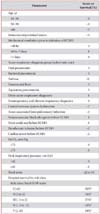Abstract
Figures and Tables
Table 1
ECMO vs. ECCO2R

Adopted from Del Sorbo L et al. Lancet Respir Med 2014;2:154-64, with permission of Elsevier3.
ECMO: extracorporeal membrane oxygenation; ECCO2R: extracorporeal CO2 removal; VV: veno-venous; VCO2: CO2 production; ACT: activated clotting time; aPTT: activated partial thromboplastin time.
Table 2
Characteristics of gas exchange and hemodynamic support during ECLS

Adopted from Del Sorbo L et al. Lancet Respir Med 2014;2:154-64, with permission of Elsevier3.
ECLS: extracorporeal life support; VV ECMO: veno-venous extracorporeal membrane oxygenation; VA: veno-arterial.
Table 3
VV ECMO for rescue treatment in patients with acute respiratory distress syndrome3

| Indication | Contraindication | |
|---|---|---|
| REVA9 | PaO2/FiO2 <50 despite PEEP 10-20 cm H2O and FiO2 >80%; Pplat >35 cm H2O despite the attempt to reduce TV <4 mL/kg PBW | Presence of severe comorbidities and multiorgan failure (SOFA score >15) |
| ANZ ECMO1 | PaO2/FiO2 <60; PaCO2 >100 mm Hg with PaO2/FiO2 <100 | Irreversible CNS condition; cirrhosis with ascites, encephalopathy, or history of variceal bleeding; active and rapidly fatal malignant disease; HIV infection; weight >120 kg; pulmonary hypertension; cardiac arrest |
| ECMOnet7 | Oxygenation index >30; PaO2/FiO2<70 with PEEP ≥15 cm H2O for patients already admitted to an ECMO center; pH <7.25 for ≥2 hr; hemodynamic instability | Intracranial bleeding or other major contraindication to anticoagulation; previous severe disability; poor prognosis because of underlying disease; mechanical ventilation >7 days |
| CESAR2 | Potentially reversible respirator y failure; Murray score ≥3; pH <7.2 despite optimum conventional treatment | PIP >30 cm H2O or FiO2>80%; mechanical ventilation >7 days; intracranial bleeding; contraindication to limited heparinization; contraindication to continuation of active treatment |
| EOLIA (NCT01470703) | PaO2/FiO2 <50 with FiO2>80% for 3 hr, despite optimum mechanical ventilation and adjunctive treatment; PaO2/FiO2 <80 with FiO2>80% for 6 hr, despite optimum mechanical ventilation and adjunctive treatment; pH <7.25 for 6 hr (RR increased to 35 beats per minute) with mechanical ventilation adjusted to keep Pplat <32 cm H2O | Mechanical ventilation ≥7 days; age <18 yr; pregnancy; weight >1 kg/cm; BMI >45 kg/m2; chronic respiratory insufficiency treated oxygen therapy of long duration and/or long-term respiratory assistance; history of heparin-induced thrombocytopenia; malignant disease with 5-year fatal prognosis; patient moribund; SAPS II >90; non-drug-induced coma following cardiac arrest; irreversible CNS pathology; decision to limit therapeutic interventions; unable to cannulate |
Adopted from Del Sorbo L et al. Lancet Respir Med 2014;2:154-64, with permission of Elsevier3.
VV ECMO: veno-venous extracorporeal membrane oxygenation; PaO2: arterial partial pressure of O2; FiO2: fraction of inspired oxygen; PEEP: positive end-expiratory pressure; TV: tidal volume; PBW: predicted body weight; SOFA: sequential organ failure assessment score; CNS: central nervous system; HIV: human immunodeficiency virus; RR: respiratory rate; BMI: body mass index; SAPS II: Simplified Acute Physiology Score.
Table 4
Clinical studies of ECLS to prevent ventilator-induced lung injury3

| ECLS technique | Mechanical ventilation strategy | ||
|---|---|---|---|
| ECLS group | Control group | ||
| Zimmermann et al.6 | Pumpless interventional lung assist | Tidal volume ≤6 mL/kg PBW, Pplat ≤30 cm H2O, RR ≤25/min, and high NHLBI ARDS network PEEP/FiO2 table | No control group |
| Terragni et al.11 | Extracorporeal CO2 removal | Tidal volume ≤4 mL/kg PBW, and high NHLBI ARDS network PEEP/FiO2 table | Tidal volume 6 mL/kg PBW |
| Bein et al.10 | Extracorporeal CO2 removal | Tidal volume 3 mL/kg PBW | Tidal volume 6 mL/kg PBW |
| PARSA study (NCT01239966) | Extracorporeal CO2 removal and renal replacement therapy | Tidal volume 4 mL/kg PBW | No control group |
| ELP study (NCT 01522599) | Extracorporeal CO2 removal | Tidal volume 4 mL/kg PBW | Tidal volume 6 mL/kg PBW |
Adopted from Del Sorbo L et al. Lancet Respir Med 2014;2:154-64, with permission of Elsevier3.
ECLS: extracorporeal life support; PBW: predicted bodyweight; Pplat: inspiratory plateau pressure; RR: respiratory rate; NHLBI: National Heart, Lung, and Blood Institute; ARDS: acute respiratory distress syndrome; PEEP: positive end-expiratory pressure; FiO2: fraction of inspired oxygen.
Table 5
Weaning from ECMO

Adopted from Richard C et al. Ann Intensive Care 2014;4:15, according to the Creative Commons License17.
ECMO: extracorporeal membrane oxygenation; VV: veno-venous; FECO2: oxygen fraction delivered by the extracorporeal circuit; Pplat: plateau pressure; TV: tidal volume; PEEP: positive end-expiratory pressure; PaO2: arterial partial pressure of O2; FiO2: fraction of inspired oxygen; PCO2: partial pressure of CO2; VA: venous-arterial.
Table 6
RESP score

Reprinted with permission of the American Thoracic Society. Copyright © 2015 American Thoracic Society. Schmidt M et al. Predicting survival after extracorporeal membrane oxygenation for severe acute respiratory failure. The Respiratory Extracorporeal Membrane Oxygenation Survival Prediction (RESP) score. Am J Respir Crit Care Med 2014;189:1374-8227. The American Journal of Respiratory and Critical Care Medicine is an official journal of the American Thoracic Society.
*Survival (%).
RESP: Respiratory ECMO Survival Prediction; ECMO: extracorporeal membrane oxygenation; PaCO2:partial pressure of carbon dioxide.




 PDF
PDF ePub
ePub Citation
Citation Print
Print


 XML Download
XML Download